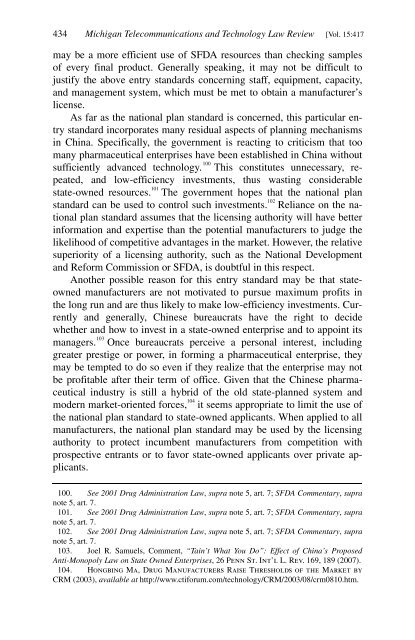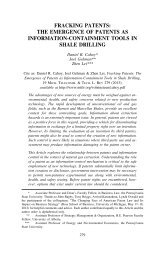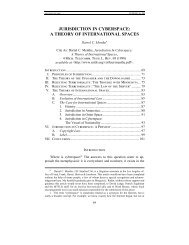the chinese regulatory licensing regime for pharmaceutical products
the chinese regulatory licensing regime for pharmaceutical products
the chinese regulatory licensing regime for pharmaceutical products
Create successful ePaper yourself
Turn your PDF publications into a flip-book with our unique Google optimized e-Paper software.
434 Michigan Telecommunications and Technology Law Review [Vol. 15:417<br />
may be a more efficient use of SFDA resources than checking samples<br />
of every final product. Generally speaking, it may not be difficult to<br />
justify <strong>the</strong> above entry standards concerning staff, equipment, capacity,<br />
and management system, which must be met to obtain a manufacturer’s<br />
license.<br />
As far as <strong>the</strong> national plan standard is concerned, this particular entry<br />
standard incorporates many residual aspects of planning mechanisms<br />
in China. Specifically, <strong>the</strong> government is reacting to criticism that too<br />
many <strong>pharmaceutical</strong> enterprises have been established in China without<br />
sufficiently advanced technology. 100 This constitutes unnecessary, repeated,<br />
and low-efficiency investments, thus wasting considerable<br />
state-owned resources. 101 The government hopes that <strong>the</strong> national plan<br />
standard can be used to control such investments. 102 Reliance on <strong>the</strong> national<br />
plan standard assumes that <strong>the</strong> <strong>licensing</strong> authority will have better<br />
in<strong>for</strong>mation and expertise than <strong>the</strong> potential manufacturers to judge <strong>the</strong><br />
likelihood of competitive advantages in <strong>the</strong> market. However, <strong>the</strong> relative<br />
superiority of a <strong>licensing</strong> authority, such as <strong>the</strong> National Development<br />
and Re<strong>for</strong>m Commission or SFDA, is doubtful in this respect.<br />
Ano<strong>the</strong>r possible reason <strong>for</strong> this entry standard may be that stateowned<br />
manufacturers are not motivated to pursue maximum profits in<br />
<strong>the</strong> long run and are thus likely to make low-efficiency investments. Currently<br />
and generally, Chinese bureaucrats have <strong>the</strong> right to decide<br />
whe<strong>the</strong>r and how to invest in a state-owned enterprise and to appoint its<br />
managers. 103 Once bureaucrats perceive a personal interest, including<br />
greater prestige or power, in <strong>for</strong>ming a <strong>pharmaceutical</strong> enterprise, <strong>the</strong>y<br />
may be tempted to do so even if <strong>the</strong>y realize that <strong>the</strong> enterprise may not<br />
be profitable after <strong>the</strong>ir term of office. Given that <strong>the</strong> Chinese <strong>pharmaceutical</strong><br />
industry is still a hybrid of <strong>the</strong> old state-planned system and<br />
modern market-oriented <strong>for</strong>ces, 104 it seems appropriate to limit <strong>the</strong> use of<br />
<strong>the</strong> national plan standard to state-owned applicants. When applied to all<br />
manufacturers, <strong>the</strong> national plan standard may be used by <strong>the</strong> <strong>licensing</strong><br />
authority to protect incumbent manufacturers from competition with<br />
prospective entrants or to favor state-owned applicants over private applicants.<br />
100. See 2001 Drug Administration Law, supra note 5, art. 7; SFDA Commentary, supra<br />
note 5, art. 7.<br />
101. See 2001 Drug Administration Law, supra note 5, art. 7; SFDA Commentary, supra<br />
note 5, art. 7.<br />
102. See 2001 Drug Administration Law, supra note 5, art. 7; SFDA Commentary, supra<br />
note 5, art. 7.<br />
103. Joel R. Samuels, Comment, “Tain’t What You Do”: Effect of China’s Proposed<br />
Anti-Monopoly Law on State Owned Enterprises, 26 Penn St. Int’l L. Rev. 169, 189 (2007).<br />
104. Hongbing Ma, Drug Manufacturers Raise Thresholds of <strong>the</strong> Market by<br />
CRM (2003), available at http://www.cti<strong>for</strong>um.com/technology/CRM/2003/08/crm0810.htm.






